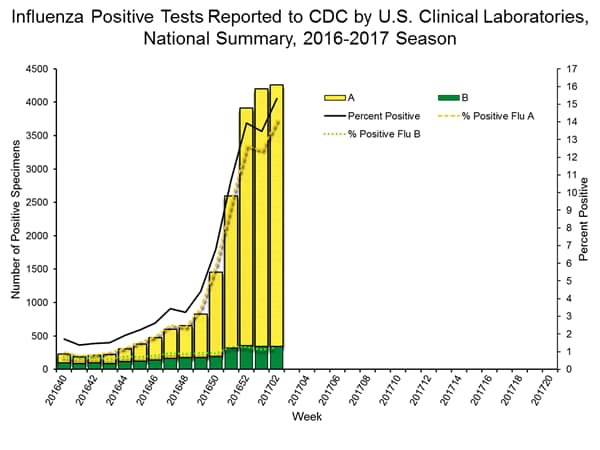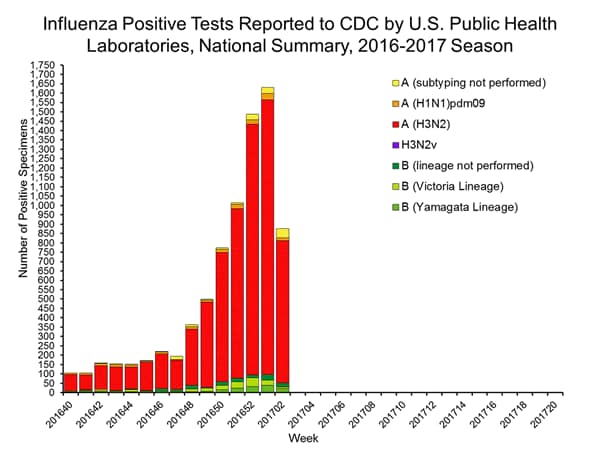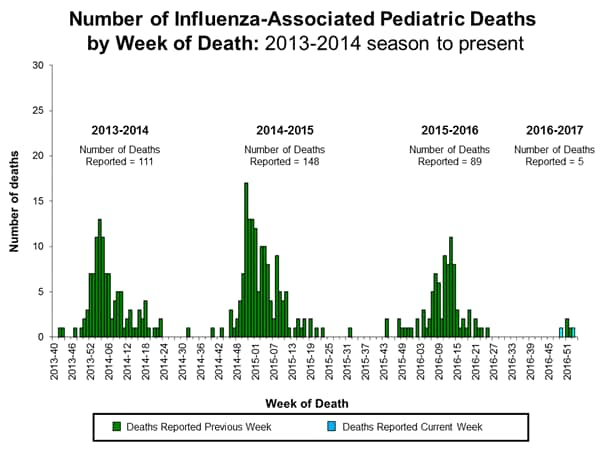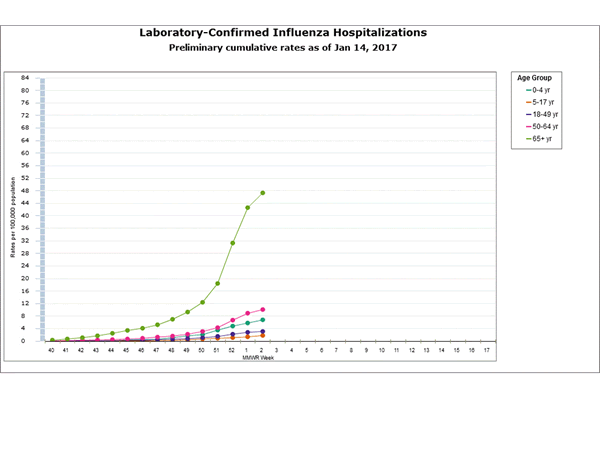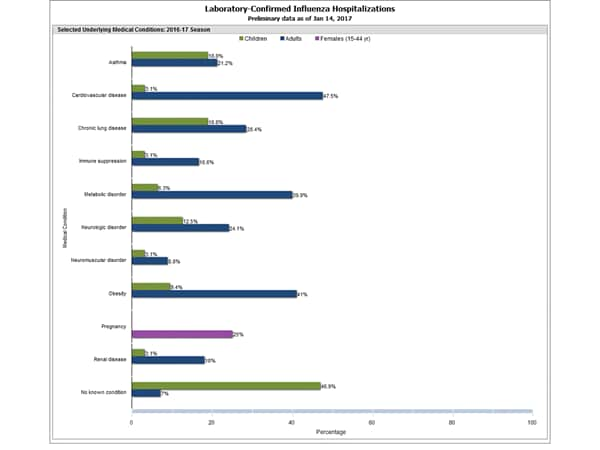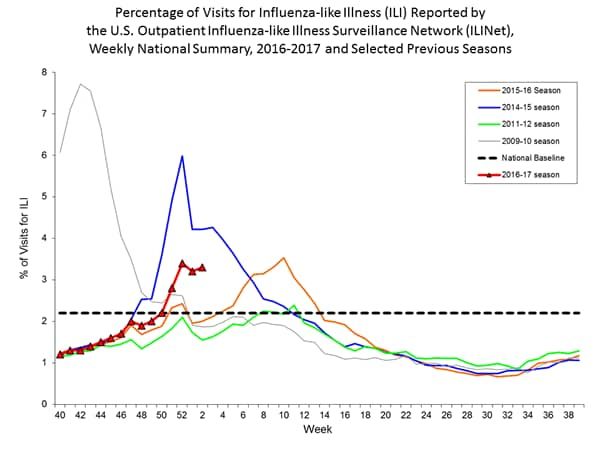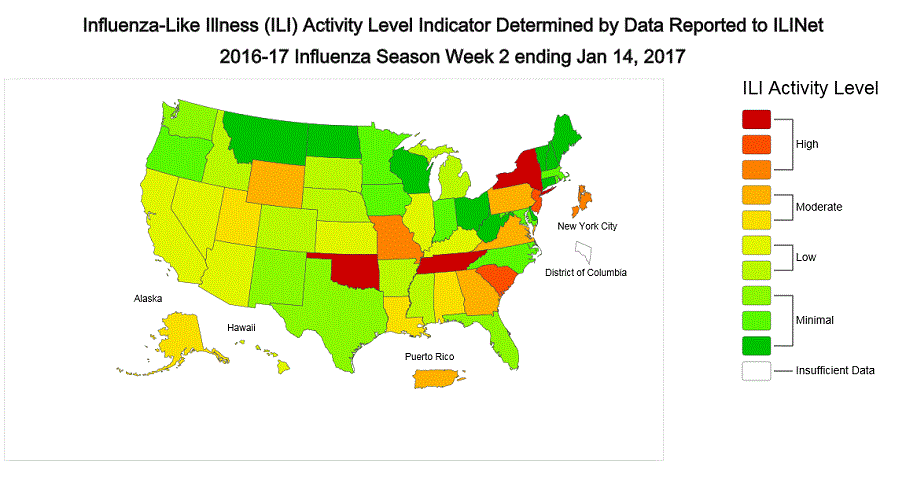Archive for January, 2017
2016-2017 Influenza Season Week 2 ending January 14, 2017
Saturday, January 21st, 2017During week 2 (January 8-14, 2017), influenza activity increased in the United States.
- Viral Surveillance: The most frequently identified influenza virus subtype reported by public health laboratories during week 2 was influenza A (H3). The percentage of respiratory specimens testing positive for influenza in clinical laboratories increased.
- Pneumonia and Influenza Mortality: The proportion of deaths attributed to pneumonia and influenza (P&I) was below the system-specific epidemic threshold in the National Center for Health Statistics (NCHS) Mortality Surveillance System.
- Influenza-associated Pediatric Deaths: Two influenza-associated pediatric deaths were reported.
- Influenza-associated Hospitalizations: A cumulative rate for the season of 10.2 laboratory-confirmed influenza-associated hospitalizations per 100,000 population was reported.
- Outpatient Illness Surveillance: The proportion of outpatient visits for influenza-like illness (ILI) was 3.3%, which is above the national baseline of 2.2%. All 10 regions reported ILI at or above their region-specific baseline levels. New York City and six states experienced high ILI activity; Puerto Rico and eight states experienced moderate ILI activity; 14 states experienced low ILI activity; 22 states experienced minimal ILI activity, and the District of Columbia had insufficient data.
- Geographic Spread of Influenza: The geographic spread of influenza in Puerto Rico and 29 states was reported as widespread; Guam and 17 states reported regional activity; the District of Columbia and four states reported local activity; and the U.S. Virgin Islands reported sporadic activity.
Neuraminidase Inhibitor Resistance Testing Results on Samples Collected Since October 1, 2016
|
Oseltamivir |
Zanamivir |
Peramivir |
||||
|---|---|---|---|---|---|---|
|
Virus Samples tested (n) |
Resistant Viruses, Number (%) |
Virus Samples tested (n) |
Resistant Viruses, Number (%) |
Virus Samples tested (n) |
Resistant Viruses, Number (%) |
|
| Influenza A (H1N1)pdm09 |
59 |
0 (0.0) |
59 |
0 (0.0) |
59 |
0 (0.0) |
| Influenza A (H3N2) |
385 |
0 (0.0) |
385 |
0 (0.0) |
319 |
0 (0.0) |
| Influenza B |
101 |
0 (0.0) |
101 |
0 (0.0) |
101 |
0 (0.0) |
The majority of recently circulating influenza viruses are susceptible to the neuraminidase inhibitor antiviral medications, oseltamivir, zanamivir, and peramivir; however, rare sporadic instances of oseltamivir-resistant and peramivir-resistant influenza A (H1N1)pdm09 viruses and oseltamivir-resistant influenza A (H3N2) viruses have been detected worldwide. Antiviral treatment as early as possible is recommended for patients with confirmed or suspected influenza who have severe, complicated, or progressive illness; who require hospitalization; or who are at high risk for serious influenza-related complications. Additional information on recommendations for treatment and chemoprophylaxis of influenza virus infection with antiviral agents is available at http://www.cdc.gov/flu/antivirals/index.htm.
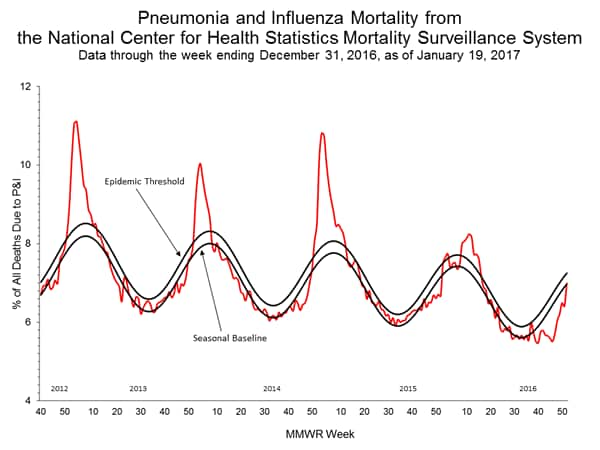
Italian avalanche: At least 10 people have been pulled out alive including a plucky 6-year-old who just wanted her favorite cookies.
Saturday, January 21st, 2017Pakistan: A bomb exploded Saturday in a market in a northwest tribal region that borders Afghanistan, killing more than 20 and wounding at least 50
Saturday, January 21st, 2017Italy: 16 badly burned bodies were pulled from the wreckage, when a bus crashed and caught fire in Italy while carrying Hungarian teenagers home from a school trip.
Saturday, January 21st, 201716 morti nel bus ungherese incendiatosi dopo scontro contro un pilone dell’A4 vicino Verona intervento #vigilidelfuoco @emergenzavvf pic.twitter.com/WYdTKB1930
— VigilFuoco Veneto (@vvfveneto) January 21, 2017
Breaking News: Two people buried in an avalanche-hit Italian mountain hotel have been rescued, while another four survivors are still inside
Friday, January 20th, 2017So far only three bodies have been recovered, with reports of a fourth, and two people saved from the 4-star Hotel Rigopiano after earthquakes in the central Italian Abruzzo region appear to have caused the avalanche.
Friday, January 20th, 20174.1. miles: The Greek Coast Guard dealing with the constant flow of rescues & saving refugees from drowning as they attempt to cross to Europe from Turkey.
Friday, January 20th, 2017GlaxoSmithKline Plc, Johnson & Johnson and Sanofi are among drugmakers backing an effort to develop new vaccines that could be deployed swiftly to contain outbreaks before they spark global emergencies.
Thursday, January 19th, 2017Iran: A high-rise in Tehran caught fire and collapsed Thursday in a giant cloud of smoke, killing at least 50 firefighters.
Thursday, January 19th, 2017Multiple earthquakes strike Italian region near Rome
Thursday, January 19th, 2017Tectonic Summary
The January 18, 2017 M 5.7 and M 5.6 earthquakes southwest of Amatrice, Italy, occurred as the result of shallow normal faulting on a NW-SE oriented fault (or faults) in the Central Apennines. The Apennines is a mountain range that runs from the Gulf of Taranto in the south to the southern edge of the Po basin in northern Italy. Geologically, the Apennines is largely an accretionary wedge formed as a consequence of subduction. This region is tectonically and geologically complex, involving subduction of the Adria micro-plate beneath Eurasia and the Apennines from east to west, continental collision between the Eurasia and Nubia (Africa) plates building the Alpine mountain belt further to the north, and the opening of the Tyrrhenian basin to the west (the latter of which is in turn related to Adria subduction and eastward trench migration). The evolution of this system has caused the expression of all different tectonic styles acting at the same time in a broad region surrounding Italy and the central Mediterranean. The January 18, 2017 normal faulting earthquakes are intraplate events, an expression of the east-west extensional tectonics that now dominate along the Apennine belt.
The January 18, 2017 earthquakes (09:25 UTC M 5.3; 10:14 UTC M 5.7; 10:25 UTC M 5.6) continue a sequence of damaging earthquakes that include:
– The August 24, 2016, M 6.2 central Italy (Amatrice) earthquake, which caused approximately 300 fatalities, and severely damaged the town of Amatrice.
– The October 26, 2016, M 6.1 central Italy earthquake, which was itself preceded by several hours by a M 5.5 earthquake. The M 6.1 earthquake resulted in damage to numerous buildings, but no fatalities.
– The October 30, 2016, M 6.6 central Italy earthquake, the largest event in the sequence to date. This event caused 20 injuries and left many homeless, and caused extensive damage, including destroying the Basilica of Saint Benedict.
Since the August 24, 2016 M 6.2 earthquake, and prior to January 18, 2017, the USGS has reported 75 events of M 4.0 and larger, including a M 5.6 earthquake within an hour of the August 24, 2016 shock, the two large events on October 26, 2016 – an M 5.5 event at 17:10 UTC, and the M 6.1 earthquake at 19:18 UTC – and the M 6.6 event on October 30, 2016. Both October 26, 2016 events were at the northern end of the aftershock sequence of the M 6.2 August 24, 2016 earthquake. The October 30, 2016, M 6.6 event occurred between the two prior largest earthquakes, approximately 10 km southeast of the October 26, 2016, M 6.1 event. The January 18, 2017 earthquakes occurred at the southern end of the sequence, about 15 km southeast of the M 6.2 August 24, 2016 earthquake.
The central Apennine region has experienced several significant earthquakes in recorded history. The largest instrumentally recorded earthquake within 100 km of the 2016-17 events was the January 13, 1915 M 6.7 earthquake, which was nearly 90 km to the south-southeast of the October 26, 2016 event, near Avezzano. The 1915 earthquake killed approximately 32,000 people. In September 1997, a Mw 6.0 earthquake 35 km west-northwest of the October 30, 2016 event killed 11, injured over 100 and destroyed approximately 80,000 homes in the Marche and Umbria regions. This 1997 event was part of a series of earthquakes known as the Umbria-Marche seismic sequence, which included eight events of magnitude greater than M5.0 in a two-month period between September and November of that year, including the events that substantially damaged the Basilica of St Francis in Assisi. In April 2009, a Mw 6.3 earthquake 60 km to the south-southeast of the October 30, 2016 event, near the town of L’Aquila, killed at least 295, injured over 1,000 and left 55,000 or more homeless. The L’Aquila earthquake resulted in significant landsliding in the local area, and was also followed by a vigorous aftershock sequence, including 5 other events of M 5.0 or larger. The location of the 2016-17 earthquake sequence is predominantly in a gap between the aftershock sequences of the 1997 and 2009 events; the January 18, 2017 events are just to the north of the northern extent of the 2009 sequence.
Further research into this ongoing sequence will more clearly determine how each event relates to other earthquakes, and how the sequence as a whole developed in space and time.


